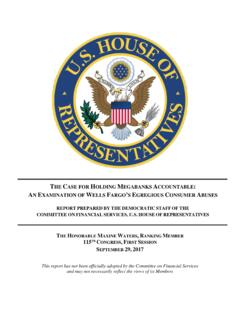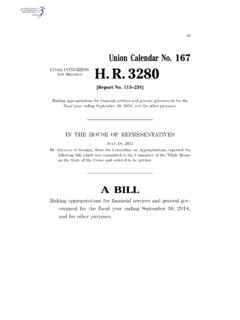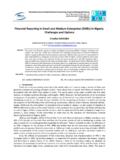Transcription of H R Khan: Financial inclusion and financial stability: are ...
1 BIS central bankers speeches 1 h r khan : Financial inclusion and Financial stability : are they two sides of the same coin? Address by Shri h r khan , Deputy Governor of the Reserve Bank of India, at BANCON 2011, organized by the Indian Bankers Association and Indian Overseas Bank, Chennai, 4 November 2011. * * * The speaker acknowledges the valuable contributions of Dr. Rabi N Mishra, Ms. Dimple Bhandia, Ms. V. Vinitha and Mr. Surajit Bose in preparation of this presentation. It is always a pleasure to be a part of such a confluence of bankers and researchers on contemporary issues in banking and finance but to choose to speak on an area which needs to be either wholesomely new or extensively revised at such a forum becomes a challenge. I thank the organizers, the CMD of Indian Overseas Bank and the Chairman of IBA for offering me this opportunity to share my own thoughts on a topical issue that has engaged attention of policy makers in India and abroad in the recent times.
2 The Reserve Bank is intimately involved in efforts to ensure both Financial inclusion and Financial stability in India. Being a part of this institution, I have had a very large intellectual as also operational canvas to roam around. That in fact, encouraged me to avail of this opportunity to discuss these two important dimensions of the economic issues which have shaped the tone and tenor of Financial sector policy space globally over the last decade or so. The more one deals with them in juxtaposition, the more their mutual exclusiveness gets demystified. Let me explain, how? The importance of Financial inclusion based on the principle of equity and on inclusive growth with stability has engaged the renewed attention of policy makers internationally in recent years. It is being increasingly recognized that despite tremendous growth in the banking sector and significant improvements in all areas relating to Financial viability, profitability and competitiveness, the glass remains half-full.
3 There remain concerns that banks have not been able to include vast segments of the population, especially the underprivileged sections of the society, into the fold of basic banking and Financial services. The recent global Financial crisis has also brought the focus on Financial stability to the centre stage. The debate has been quite wide-ranging encompassing, inter alia, the definition of Financial stability and the implication of Financial stability for growth and welfare. Many lessons have been learnt. One, that Financial stability can be jeopardized even if there is price and macroeconomic stability . Two, that Financial stability has to shift from being an implicit variable to an explicit variable of economic policy and three, that a threat to Financial stability anywhere in the world is potentially a threat to Financial stability everywhere.
4 Fourth and most importantly, we have learnt that while Financial instability can hurt even the most advanced economies, the damage it can cause in poor and developing economies can be particularly severe. People with low levels of income have no headroom to bear downside risks, and their livelihoods can be disrupted by Financial instability. It is therefore even more important that countries such as ours pay particular attention to preserving Financial stability even as we deepen and broaden our Financial sector at home and integrate with the rest of the world1. The developments in the recent years have ensured that the pursuit of Financial inclusion and the pursuit of Financial stability are no longer policy options but policy compulsions. The key challenges emerging from this conclusion is how to achieve the goal of Financial inclusion , 1 Financial stability : Issues and Challenges , D.
5 Subbarao, September 2009. 2 BIS central bankers speeches , providing basic Financial facilities to a wider segment of society while ensuring that the stability of the Financial system is not compromised. An important question which emerges is whether increased and wider access to the formal Financial services works in tandem with policies aimed at enhancing Financial stability or does it work at cross purposes and jeopardize Financial stability , , are Financial inclusion and Financial stability two sides of the same coin or are they two different disparate goals. These are some of the issues I have picked up to enunciate. First, I will share my thoughts on how Financial inclusion and Financial stability must co-exist and that it is difficult, in the longer term, to envisage prevalence of one without the other.
6 Next, I will discuss the various ways in which Financial stability and Financial inclusion complement each other, going on to discuss the ways that they may be in conflict and work at cross purposes. I will then touch upon how a suite of enabling regulatory framework, effective policies for consumer protection and greater Financial awareness and literacy can work together to exploit the synergies between Financial inclusion and Financial stability . Finally, I will briefly outline the manner in which Financial stability considerations have been woven into the Reserve Bank s initiatives towards greater Financial inclusion . Financial inclusion and Financial stability : mandatory co-existence The first point I would like to make as I explore the relationship between Financial stability and Financial inclusion is that the two must co-exist.
7 Financial inclusion may be difficult without the stability of the Financial system while it is difficult to envisage continuing Financial stability when an increasing chunk of the socio-economic system remains financially excluded. Let me elucidate. Financial inclusion has been defined, by the Committee on Financial inclusion , as the process of ensuring access to Financial services and timely and adequate credit where needed by vulnerable groups such as weaker sections and low income groups at an affordable cost2. It primarily represents access to a bank account backed by deposit insurance, access to affordable credit and the payments system. There has been significant, albeit, slow progress towards greater Financial inclusion around the world in recent years. According to estimates by an ADB Working Paper3, in Africa, Kenya has pioneered an interesting process of Financial inclusion through mobile phone payment solutions.
8 Latin American countries such as Peru and Bolivia have attempted to put in place some very enabling regulatory environments for microfinance. In these two countries, rapid growth over the past seven years has included six million clients in the formal Financial system. Brazilian policymakers achieved universal coverage of over 5,500 municipalities by enabling banks to use retail agents. This new low-cost delivery channel triggered expansion of formal Financial services to 12 million clients in only six years. Latin America has also demonstrated the potential of conditional cash transfers into simplified bank accounts as a way to connect beneficiaries to formal finance while simultaneously lowering delivery costs to the government. Transfer challenges motivated the use of agents in Brazil.
9 In Mexico, beneficiaries increased savings and investment with more than 90 per cent of households started to use banking services. The benefits from Financial inclusion are well understood and well documented. Financial inclusion , more particularly when promoted in the wider context of economic inclusion , can uplift Financial conditions and improve the standards of lives of the poor and the disadvantaged. Access to affordable Financial services would lead to increasing economic 2 As defined by the Committee on Financial inclusion (Chairman: C. Rangarajan, 2008). 3 ADBI Working Paper Series No. 259 Financial inclusion and Financial stability : Current Policy Issues (Dec 2010). BIS central bankers speeches 3 activities and employment opportunities for rural households with a possible multiplier effect on the economy.
10 It could enable a higher disposable income in the hands of rural households leading to greater savings and a wider deposit base for banks and other Financial institutions. It will enable the Government to provide social development benefits and subsidies directly to the beneficiary bank accounts, thereby drastically reducing leakages and pilferages in social welfare schemes. Thus, Financial inclusion could be an instrument to provide monetary fuel for economic growth and is critical for achieving inclusive growth. Further, expanding the reach of Financial services to those individuals who do not currently have access would be an objective that is fully consistent with the people-centric definition of inclusive growth which attempts to bridge the various divides in an economy and society, between the rich and the poor, between the rural and urban populace, and between one region and another.



















